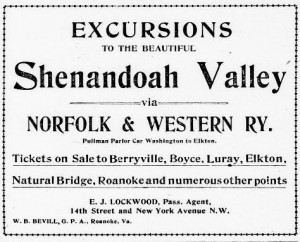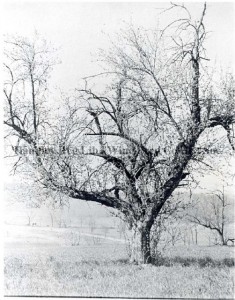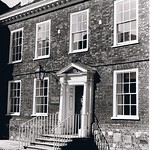We continue our peek into the past this Friday with the 1914 historical and trade edition of the Winchester Evening Star. It is no stretch to say Winchester has always been proud of its history, and this can clearly been seen here. The paper leads with a promising block of introductory text:
Winchester, Virginia
Situated in the “Vale of Shenandoah” between the enchanted Blue Ridge and Alleghenies in a God-blessed and sun-kissed land of peace and plenty. Situated 70 miles from Washington, capital of the nation, and 112 from Baltimore, the “Metropolis of the South.” Located in a magnificent agricultural country in the famous apple belt. Once the home of George Washington and other noted men. Here sleeps Daniel Morgan, “Thunderbolt of the American Revolution” and the proud Lord Fairfax. An important educational and financial centre. Brief review of her past and present history with sketches of leading men and enterprises which have placed her in the present pre-eminent and exalted position she holds in the sisterhood of American cities.
The history of Winchester through the founding by James Wood through the Civil War was brief but full of intriguing tidbits of local lore. Most residents have heard the story of Winchester changing hands 72 times during the Civil War; a lesser known exchange happened at our Taylor Hotel and was recorded in this history of Winchester:
In a single day the old and famous Taylor House on Main [Loudoun] Street was taken and retaken five times in a single day, and was literally drenched in the blood of contending troops. . . . It was used as a hospital for the wounded of both armies, and thousands of limbs were amputated there. It is related by residents of the city that they have seen in the alley running along the side of the building, large and grewsome [sic] piles of arms and legs. These were carted away daily and buried, with little ceremony, in unmarked graves on the outskirts of the city with no distinction being made between the Blue and the Gray.
The list of famous guests at the Taylor were noted in this article to include George Washington, Daniel Morgan, and Davy Crockett, all of whom most assuredly visited the log tavern that operated at the site of the current Taylor Hotel, and which was replaced in the 1830s by the brick structure following a fire at the log structure. Also new on this list, though not surprising, is William McKinley, as many know he was made a Mason here in Winchester.
While history is a focal point of the paper, its real aim was to promote the people and businesses of of Winchester in 1914. One possibly surprising statistic cited was that New Winchester (so-called for the rebuilding of the town after the ravages of the Civil War) had nearly every important business enterprise in the town (80%) operated by someone “born and bred” in the area.
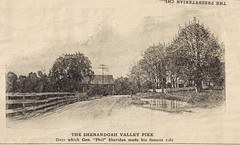 The Valley Pike, along with eight other macadamized roads that lead to Winchester, was praised as the reason Winchester is a hub of trade. Apples, of course, received the lion’s share of coverage in the section on agriculture. Perhaps the best nugget is the legend of how Apple Pie Ridge was named. According to the author, the German settlers on the ridge brought young apple trees with them, and when the trees began bearing fruit, the housewives “baked apple pies incessantly for their families.” The pies became so famous that people “from far and near” would visit to feast on the tasty treats.
The Valley Pike, along with eight other macadamized roads that lead to Winchester, was praised as the reason Winchester is a hub of trade. Apples, of course, received the lion’s share of coverage in the section on agriculture. Perhaps the best nugget is the legend of how Apple Pie Ridge was named. According to the author, the German settlers on the ridge brought young apple trees with them, and when the trees began bearing fruit, the housewives “baked apple pies incessantly for their families.” The pies became so famous that people “from far and near” would visit to feast on the tasty treats.
 The churches of Winchester received a very brief paragraph of coverage, but the lack of written information is offset by the inclusion of a photograph of the Cork Street Baptist Church, which has been demolished. The church, which appears to have been a brick building with highly ornamental Gothic embellishments, was once located between the Old John Kerr School and the Red Lion Tavern.
The churches of Winchester received a very brief paragraph of coverage, but the lack of written information is offset by the inclusion of a photograph of the Cork Street Baptist Church, which has been demolished. The church, which appears to have been a brick building with highly ornamental Gothic embellishments, was once located between the Old John Kerr School and the Red Lion Tavern.
The topic of Winchester’s many benefactors was again raised, with this edition focusing on the Handley bequests to the City, said to amount to about $1.5 million. Although not a native or resident of Winchester, Handley was fond of the town and set aside a portion of his wealth (primarily derived from anthracite coal discovered on property he owned in Lackawanna Co. in PA). Lesser known educational benefactors John Kerr and R.A. Robinson were also mentioned in passing for their contributions to public schools.
The volunteer fire companies of Winchester also had a lively write up on which company could lay claim to being the oldest in town, with Friendship, Charley Rouss, and Sarah Zane all having their share of “firsts.” The author, however, dismisses all three as being the oldest fire company in Winchester, as “none of them are the original fire company, for files of old newspapers prove that there were at least two companies organized in Winchester considerably more than a century ago.”
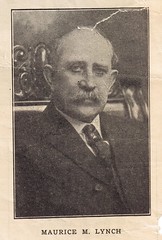 The people in this edition are primarily judicial and civil servants. It is interesting to note that while all the businessmen previously detailed in earlier Friday Photos posts were honest and upright citizens, the paper has a slightly different angle for these fellows. They have “a large circle of friends” and are “public spirited” and “progressive” citizens. Among those pictured are Winchester’s Mayor Julian F. Ward, Hon. Thomas W. Harrison, Hon. Richard Evelyn Byrd, Major Holmes Conrad, Hon. Hal D. Flood, Commonwealth’s Attorney Herbert Larrick, Commisioner of Revenue J.E. Correll, Commonwealth’s Attorney James P. Reardon, Superintendent of County Schools Maurice Lynch, and Superintendent of Water and Sewers Thomas J. Trier. Each has a biographical sketch, but the most interesting may be that of Maurice Lynch. He had struggled to receive an education, and could not complete his schooling at UVA for financial reasons. He persisted, however, by teaching school himself (eventually becoming superintendent) and studying law on his own in the office of Judge William Clark, and was subsequently admitted to the bar in 1887.
The people in this edition are primarily judicial and civil servants. It is interesting to note that while all the businessmen previously detailed in earlier Friday Photos posts were honest and upright citizens, the paper has a slightly different angle for these fellows. They have “a large circle of friends” and are “public spirited” and “progressive” citizens. Among those pictured are Winchester’s Mayor Julian F. Ward, Hon. Thomas W. Harrison, Hon. Richard Evelyn Byrd, Major Holmes Conrad, Hon. Hal D. Flood, Commonwealth’s Attorney Herbert Larrick, Commisioner of Revenue J.E. Correll, Commonwealth’s Attorney James P. Reardon, Superintendent of County Schools Maurice Lynch, and Superintendent of Water and Sewers Thomas J. Trier. Each has a biographical sketch, but the most interesting may be that of Maurice Lynch. He had struggled to receive an education, and could not complete his schooling at UVA for financial reasons. He persisted, however, by teaching school himself (eventually becoming superintendent) and studying law on his own in the office of Judge William Clark, and was subsequently admitted to the bar in 1887.
View the full set of photos on Flickr.
